Chapter 4 - Current Electricity - Exercises and MCQ Exercise 209
Question 1
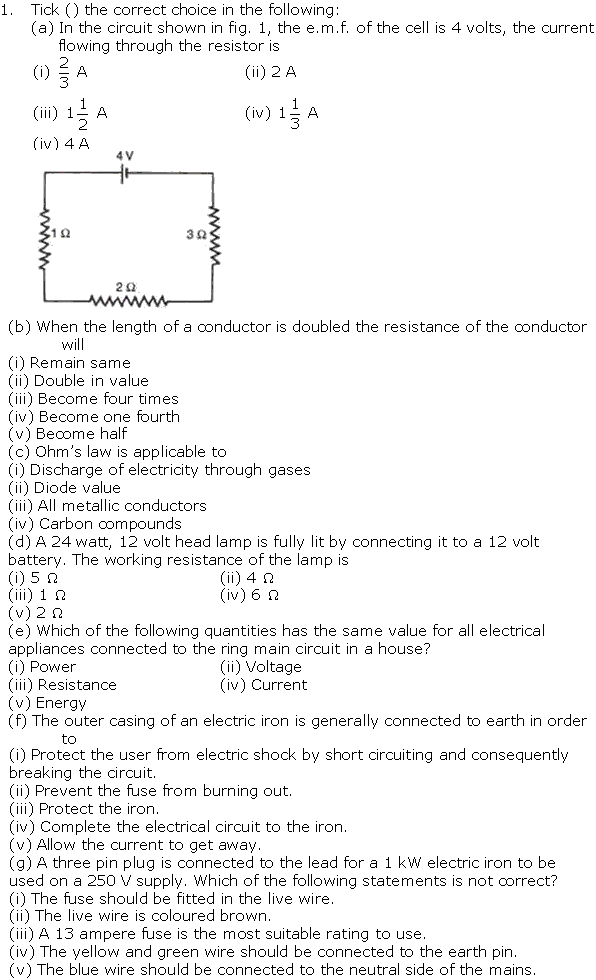
Solution 1
(a)
(i) 2/3 A
(b)
(ii) double in value
(c)
(iv) ohmic conductors
(d)
(iv) 6 ?
(e)
(ii) voltage
(f)
(i) protect the user from electric shock by short circuiting and consequently breaking the circuit.
(g)
(iii) A 13 ampere fuse is the most suitable rating to use
(i) 2/3 A
(b)
(ii) double in value
(c)
(iv) ohmic conductors
(d)
(iv) 6 ?
(e)
(ii) voltage
(f)
(i) protect the user from electric shock by short circuiting and consequently breaking the circuit.
(g)
(iii) A 13 ampere fuse is the most suitable rating to use
Question 2
Define the following:
(a) Potential difference
(b) (i) Coulomb
(ii) Ohm
(c) Electromotive force
(d) Semiconductors
(e) Super conductors.
(a) Potential difference
(b) (i) Coulomb
(ii) Ohm
(c) Electromotive force
(d) Semiconductors
(e) Super conductors.
Solution 2
(a) Potential difference: The potential difference between two points may be defined as the work done in moving a unit positive charge from one point to the other.
(b) (i) Coulomb: It is the unit of charge.
(ii) Ohm: It is the unit of resistance. The resistance of a conductor is said to be 1 ohm, if 1 ampere current flows through it, when the potential difference across its ends is 1 volt.
(c) Electromotive force: When no current is drawn from a cell, when the cell is in open circuit, the potential difference between the terminals of the cell is called its electromotive force (or e.m.f.).
(d) Semiconductors: Substances whose resistance decreases with the increase in temperature are named as semiconductors. E.g. manganin, constantan etc.
(e) Superconductors: Substance whose resistance decreases tremendously with the decrease in temperature and reaches nearly zero around absolute zero temperature are named as superconductors; e.g. lead, tin etc.
(b) (i) Coulomb: It is the unit of charge.
(ii) Ohm: It is the unit of resistance. The resistance of a conductor is said to be 1 ohm, if 1 ampere current flows through it, when the potential difference across its ends is 1 volt.
(c) Electromotive force: When no current is drawn from a cell, when the cell is in open circuit, the potential difference between the terminals of the cell is called its electromotive force (or e.m.f.).
(d) Semiconductors: Substances whose resistance decreases with the increase in temperature are named as semiconductors. E.g. manganin, constantan etc.
(e) Superconductors: Substance whose resistance decreases tremendously with the decrease in temperature and reaches nearly zero around absolute zero temperature are named as superconductors; e.g. lead, tin etc.
Question 3
State Ohm's law. What are its limitations?
Solution 3
According to Ohm's law, the current flowing in a conductor is directly proportional to the potential difference across its ends provided the physical conditions and temperature of conductor remains constant.
Limitations of Ohm's law:
1. Ohm's law does not apply to conductors such as diode, radio valves, metal rectifiers, where electricity passes through gases.
2. Ohm's law is applicable only when the physical conditions remain constant.
3. Ohm's law is applicable only when the temperature of the conductor is constant.
Limitations of Ohm's law:
1. Ohm's law does not apply to conductors such as diode, radio valves, metal rectifiers, where electricity passes through gases.
2. Ohm's law is applicable only when the physical conditions remain constant.
3. Ohm's law is applicable only when the temperature of the conductor is constant.
Question 4
What are the factors on which the resistance of a conductor depends? Distinguish between conductors and insulators.
Solution 4
Factors on which the resistance of a conductor depends are:
(i) Nature of conductor: different materials have different concentration of free electrons and therefore resistance of a conductor depends on its material.
(ii) Length of conductor: Resistance of a conductor is directly proportional to the length of a conductor.
(iii) Area of cross-section of a conductor: Resistance of a conductor is inversely proportional to the area of cross-section of the uniform wire.
(iv) Temperature of conductor: In general for metallic conductors, higher the temperature larger is the resistance.
Materials which allow electric charges to flow through them easily are known as conductors. E.g. metals and materials which do not allow the electric charge to flow through them are known as insulators. E.g. rubber, dry wood etc.
(i) Nature of conductor: different materials have different concentration of free electrons and therefore resistance of a conductor depends on its material.
(ii) Length of conductor: Resistance of a conductor is directly proportional to the length of a conductor.
(iii) Area of cross-section of a conductor: Resistance of a conductor is inversely proportional to the area of cross-section of the uniform wire.
(iv) Temperature of conductor: In general for metallic conductors, higher the temperature larger is the resistance.
Materials which allow electric charges to flow through them easily are known as conductors. E.g. metals and materials which do not allow the electric charge to flow through them are known as insulators. E.g. rubber, dry wood etc.
Chapter 4 - Current Electricity - Exercises and MCQ Exercise 210
Question 1
Solution 1
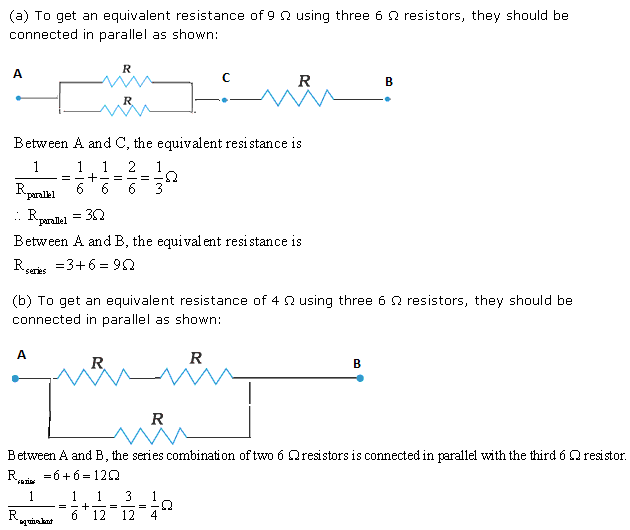
Question 2

Solution 2
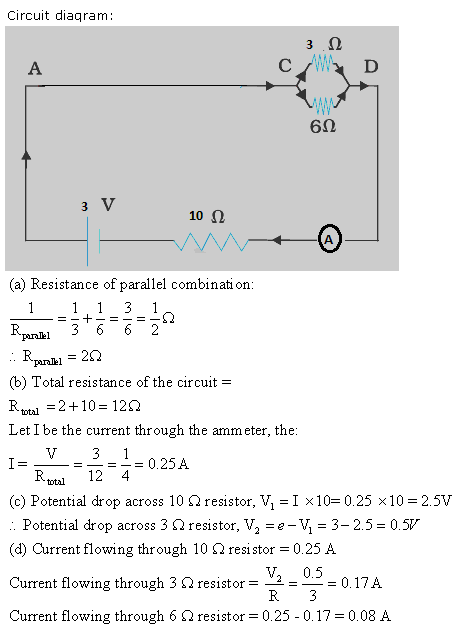
Question 3
Fig. 2 represents the circuit used for the verification of Ohm's law. Label the parts from A to F. state the function of each.
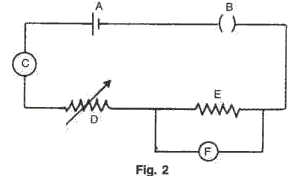

Solution 3
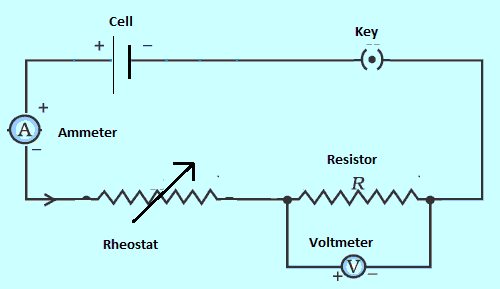
Functions:
(A) Cell- It provides the potential difference in the circuit.
(B) Key- It serves as a switch in the circuit. It supplies or cuts off current as required.
(C) Ammeter- It measures the current in the circuit.
(D) Rheostat- It helps to change the resistance of the circuit without changing its voltage.
(E) Resistor- It provides a constant resistance in the circuit.
(F) Voltmeter- It measure the potential drop across the resistor.
Question 4
What is the combined resistance of each of the networks between A and B shown in fig. 3?
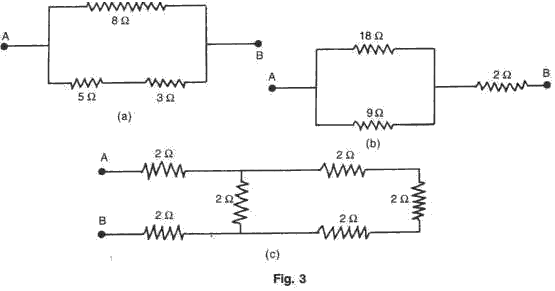

Solution 4
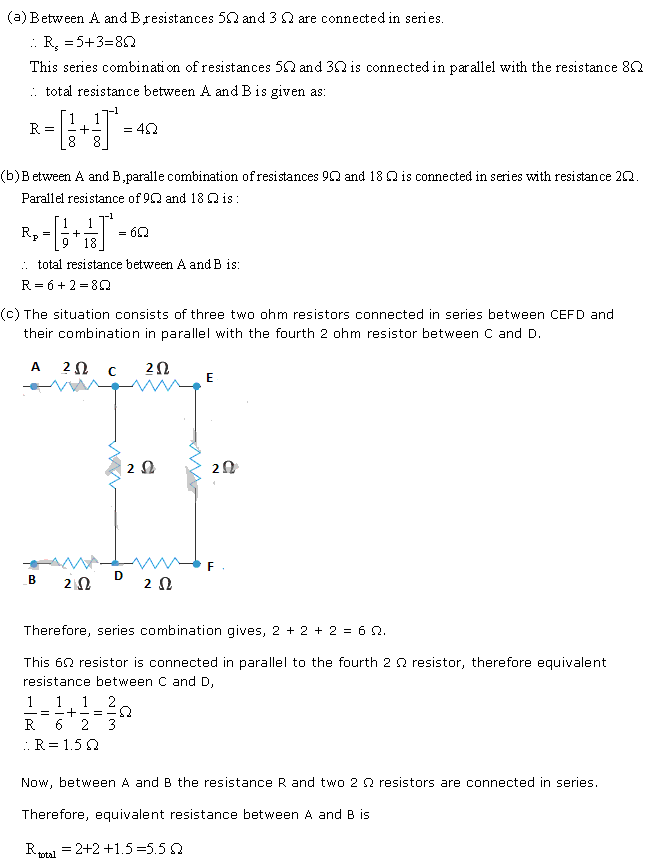
Question 5
A charge of 80 C flows in a conductor for 2 minutes.
(a) Calculate the current flowing through the conductor.
(b) If the current through a heater is 4 A what charge must be passing in 8 seconds?
(a) Calculate the current flowing through the conductor.
(b) If the current through a heater is 4 A what charge must be passing in 8 seconds?
Solution 5
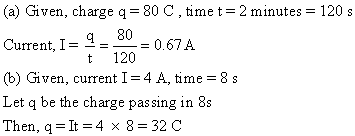
Question 6

Solution 6

Question 7
Two resistors P and Q of the same material and length but of different thickness are connected in parallel to a battery. The cross- sectional area of P is twice that of Q. What is the ratio of
(a) The resistance of P to the resistance of Q?
(b) The current in P to the current in Q?
(a) The resistance of P to the resistance of Q?
(b) The current in P to the current in Q?
Solution 7
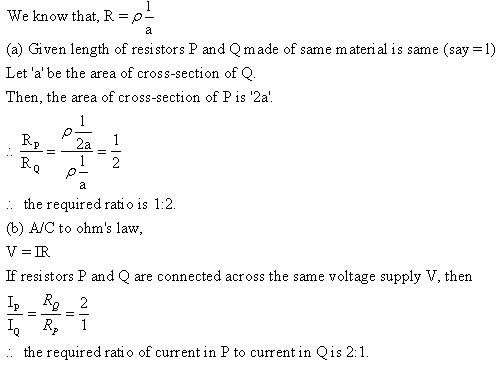
Chapter 4 - Current Electricity - Exercises and MCQ Exercise 211
Question 1
Find the effective resistance in each of the following circuit diagrams (Fig. 4):
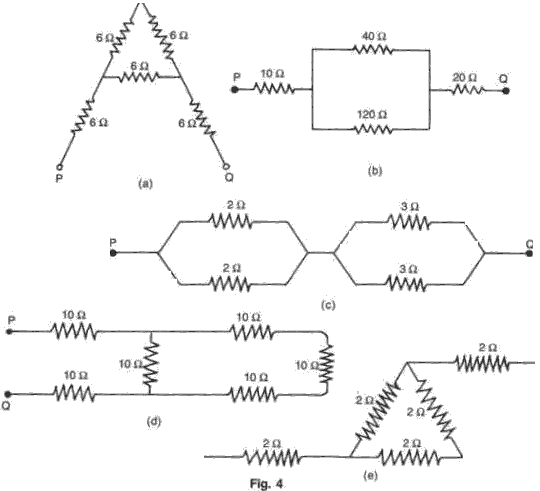

Solution 1
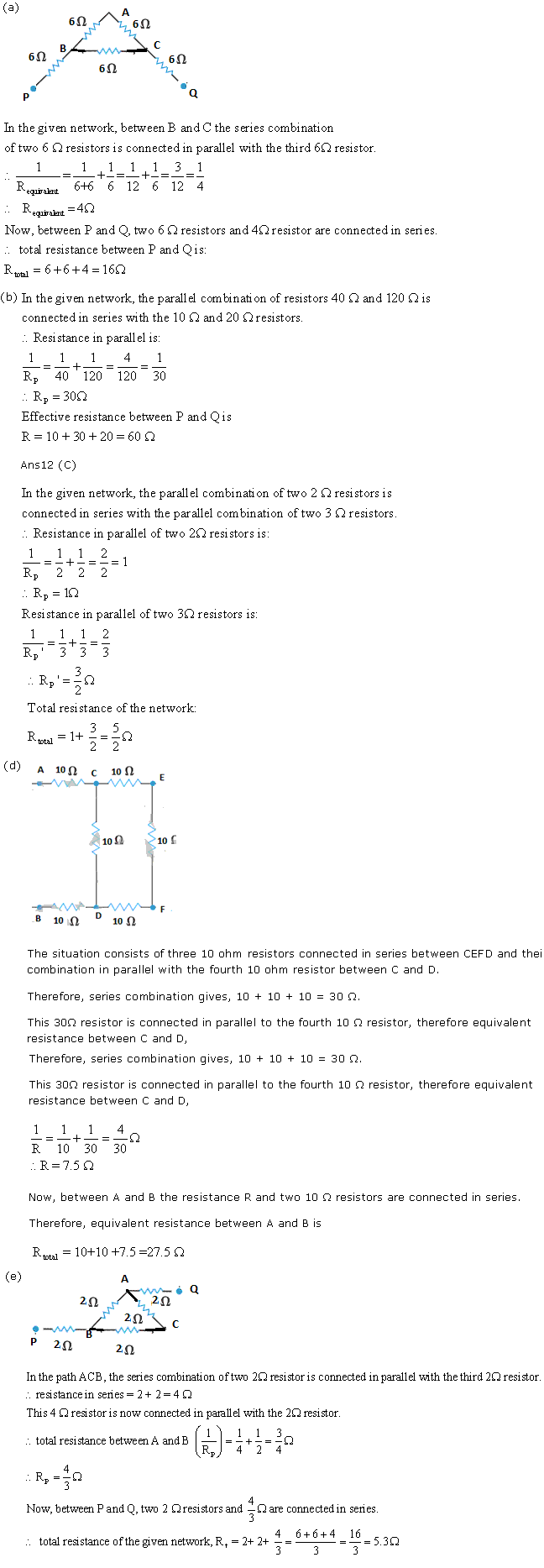
Question 2
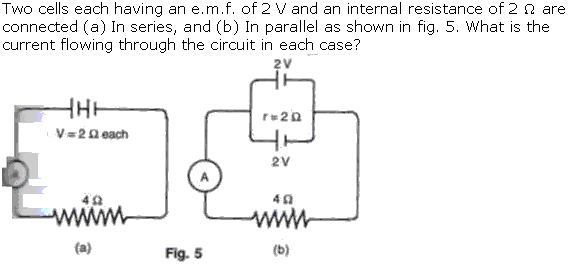
Solution 2

Question 3
In the circuit shown in fig. 6, find the reading of the ammeter A when the switch S is
(a) Opened.
(b) Closed.
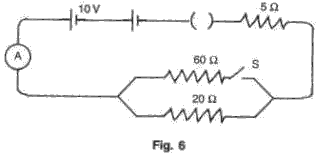
(a) Opened.
(b) Closed.

Solution 3
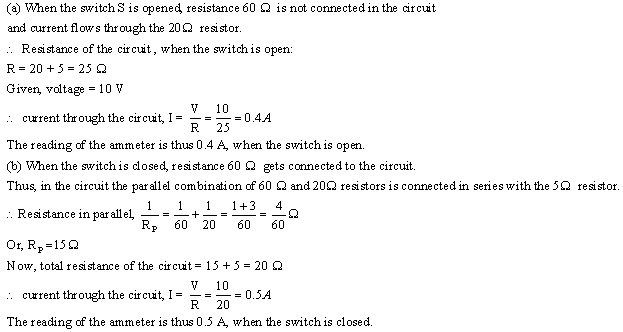
Question 4
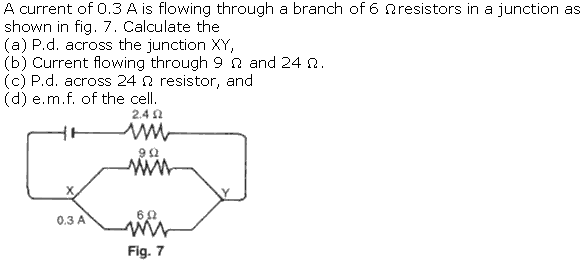
Solution 4
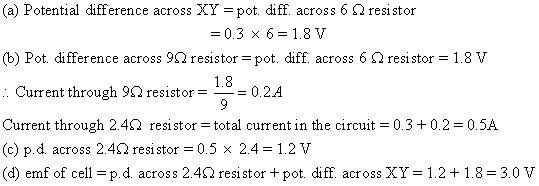
Chapter 4 - Current Electricity - Exercises and MCQ Exercise 212
Question 1
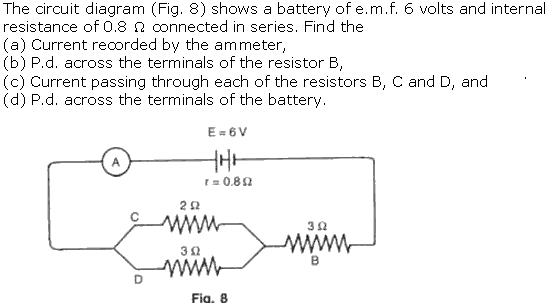
Solution 1
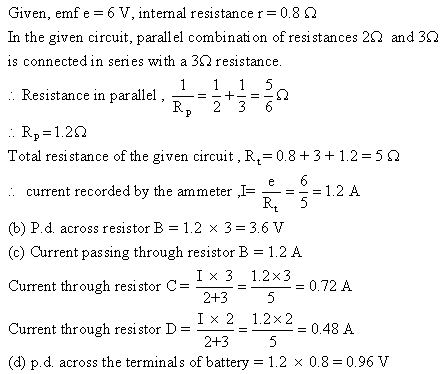
Question 2

Solution 2

Question 3
The following appliances are to be used on 240 V supply. Calculate the current used by each and say which fuse, 2 amp, 5 amp or 13 amp should be incorporated with each, (i) A television rated at 150 W, (ii) An electric iron rated at 750 W, (iii) An immersion heater rated at 3000 W, (iv) A hair dryer rated at 500 W. How much will it cost to run the television set for 100 days for an average of 4 hours a day at 60 paise per unit?
Solution 3
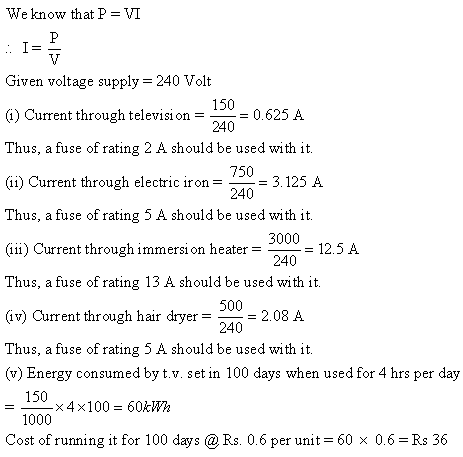
Question 4
(a) What is the purpose of fuse in an electrical circuit?
(b) What is the criteria for selecting a fuse wire?
(c) If a fuse contains a 5 A fuse wire and the voltage is 240 V, what is the maximum power (wattage) which may be taken from the circuit?
(d) What would be the danger involved in replacing a blown fuse with the one which would carry a large current?
(b) What is the criteria for selecting a fuse wire?
(c) If a fuse contains a 5 A fuse wire and the voltage is 240 V, what is the maximum power (wattage) which may be taken from the circuit?
(d) What would be the danger involved in replacing a blown fuse with the one which would carry a large current?
Solution 4
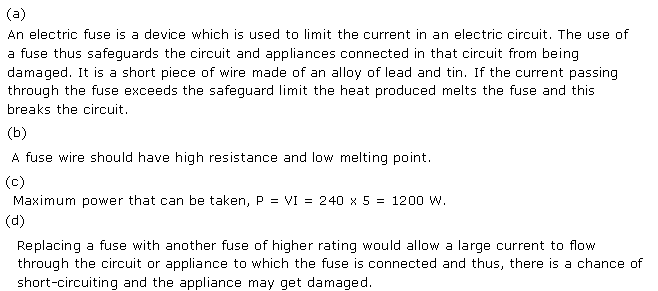
Question 5
An electric kettle has a heating element which is rated at 2 kW when connected to a 250 V electric supply. Calculate the
(a) Current which flows in the element when it is connected to a 250 V supply,
(b) Resistance of the filament,
(c) Heat produced in 1 minute by the element,
(d) Cost of running the kettle for 10 minutes a day for 30 days of the month, at the rate of Rs. 3.00 per unit.
(a) Current which flows in the element when it is connected to a 250 V supply,
(b) Resistance of the filament,
(c) Heat produced in 1 minute by the element,
(d) Cost of running the kettle for 10 minutes a day for 30 days of the month, at the rate of Rs. 3.00 per unit.
Solution 5

Question 6
Three fuses available are rated at 2 A, 10 A and 13 A. Which fuse would you chose for an electric wire rated at 3 kW, 250 V? Show how you arrived at your answer.
Solution 6

Question 7
60 joules of heat was dissipated in a resistor when 20 C flowed for 5 s. Calculate:
(a) P.d. across the resistor,
(b) Resistance of the resistor, and
(c) Average power dissipated in the resistor.
(a) P.d. across the resistor,
(b) Resistance of the resistor, and
(c) Average power dissipated in the resistor.
Solution 7

Question 8
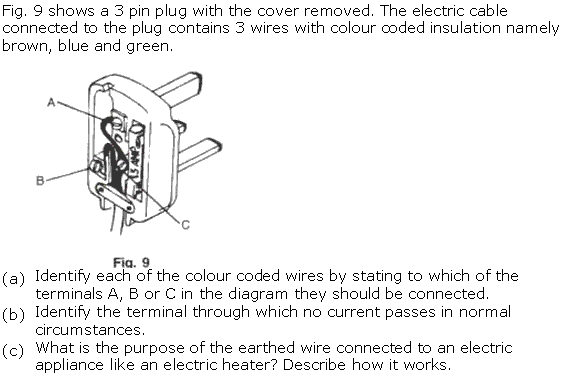
Solution 8
(a) Brown wire or live wire should be connected to terminal C.
Blue wire or neutral wire should be connected to terminal B.
Green wire or earth wire should be connected to terminal A.
(b) No, current passes through the earth terminal i.e. terminal A in normal circumstances.
(c) The metal case of an electrical appliance is earthed so that in any case of accidental contact of live wire with the metallic body of the appliance, the earth wire would provide a safe and easy path for the electric charges to flow down to the earth which acts as very large sink. Thus, user is thereby protected from any fatal electric shock.
Blue wire or neutral wire should be connected to terminal B.
Green wire or earth wire should be connected to terminal A.
(b) No, current passes through the earth terminal i.e. terminal A in normal circumstances.
(c) The metal case of an electrical appliance is earthed so that in any case of accidental contact of live wire with the metallic body of the appliance, the earth wire would provide a safe and easy path for the electric charges to flow down to the earth which acts as very large sink. Thus, user is thereby protected from any fatal electric shock.
Question 9
Explain the meaning of the term kilowatt hour.
Solution 9
'kilowatt-hour' is the commercial unit of electricity. One kilo-watt hour is the electrical energy consumed by an electrical appliance of power 1 kW when it is used for 1 hour.
Chapter 4 - Current Electricity - Exercises and MCQ Exercise 213
Question 1
In a house there are 6 bulbs of 100 W each used for 4 hours a day, 4 bulbs of 60 W each used for 8 hours a day, an immersion heater of 2.5 kW used for 1 hour per day, and an electric iron of 800 W used for 2 hours per day. Calculate the cost of monthly electric bill for the month of April at the rate of 80 p per unit.
Solution 1
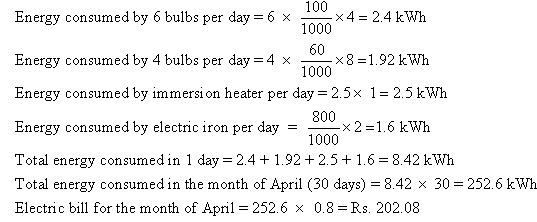
Question 2
Describe the construction and working of a filament lamp. List the material used and state why they are suitable for their purpose in this lamp.
Solution 2
Construction and working of filament bulb
List of materials used:
Light bulbs have two metal contacts, which connect to the ends of an electrical circuit. The metal contacts are attached to two stiff wires, which are attached to a thin metal filament. The filament sits in the middle of the bulb, held up by a glass mount. The wires and the filament are housed in a glass bulb, which is filled with an inert gas, such as argon.
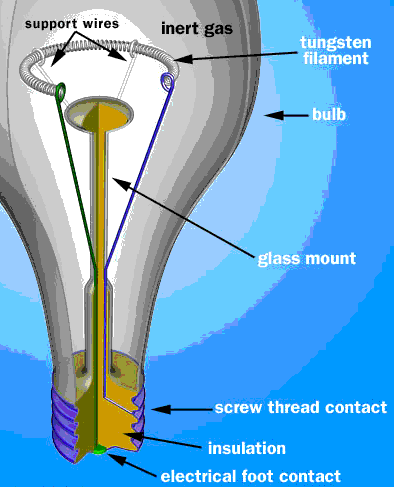
When the bulb is connected to a power supply, an electric current flows from one contact to the other, through the wires and the filament.
As the electrons zip along through the filament, they are constantly bumping into the atoms that make up the filament. The energy of each impact vibrates an atom -- in other words, the current heats the atoms up.
Metal atoms release mostly infrared light photons, which are invisible to the human eye. But if they are heated to a high enough level -- around 4,000 degrees Fahrenheit in the case of a light bulb -- they will emit a good deal of visible light.
Tungsten is used in nearly all incandescent light bulbs because it is an ideal filament material.
In a modern light bulb, inert gases, typically argon, greatly reduce this loss of tungsten. At extreme temperatures, the occasional tungsten atom vibrates enough to detach from the atoms around it and flies into the air resulting in its evaporation. In the rpesence of argon gas around it, the chances are that it will collide with an argon atom and bounce right back toward the filament, where it will rejoin the solid structure. Also since inert gases normally don't react with other elements, there is no chance of the elements combining in a combustion reaction.
List of materials used:
Light bulbs have two metal contacts, which connect to the ends of an electrical circuit. The metal contacts are attached to two stiff wires, which are attached to a thin metal filament. The filament sits in the middle of the bulb, held up by a glass mount. The wires and the filament are housed in a glass bulb, which is filled with an inert gas, such as argon.

When the bulb is connected to a power supply, an electric current flows from one contact to the other, through the wires and the filament.
As the electrons zip along through the filament, they are constantly bumping into the atoms that make up the filament. The energy of each impact vibrates an atom -- in other words, the current heats the atoms up.
Metal atoms release mostly infrared light photons, which are invisible to the human eye. But if they are heated to a high enough level -- around 4,000 degrees Fahrenheit in the case of a light bulb -- they will emit a good deal of visible light.
Tungsten is used in nearly all incandescent light bulbs because it is an ideal filament material.
In a modern light bulb, inert gases, typically argon, greatly reduce this loss of tungsten. At extreme temperatures, the occasional tungsten atom vibrates enough to detach from the atoms around it and flies into the air resulting in its evaporation. In the rpesence of argon gas around it, the chances are that it will collide with an argon atom and bounce right back toward the filament, where it will rejoin the solid structure. Also since inert gases normally don't react with other elements, there is no chance of the elements combining in a combustion reaction.
Question 3
Name the material and type of wires for the following:
(a) Connecting wires for lighting
(b) Fuse wire
(c) Heating elements
(d) Connecting wires of a power line
(e) Earthing elements
(a) Connecting wires for lighting
(b) Fuse wire
(c) Heating elements
(d) Connecting wires of a power line
(e) Earthing elements
Solution 3
(a) Connecting wires: Materials having low resistance low resistivity and high melting point e.g. copper, aluminium.
(b) Fuse wire: Materials having high resistance and low melting point e.g. solder an alloy of lead and tin.
(c) Heating element: Materials having high resistivity and high melting point e.g. tungsten.
(d) Connecting wire of a power line: Materials having low resistance and non-corosive properties e.g. high tension wires.
(e) Earthing elements: Materials which are good conductors of electricity. Earthing elements are copper wire, copper plate, salt.
(b) Fuse wire: Materials having high resistance and low melting point e.g. solder an alloy of lead and tin.
(c) Heating element: Materials having high resistivity and high melting point e.g. tungsten.
(d) Connecting wire of a power line: Materials having low resistance and non-corosive properties e.g. high tension wires.
(e) Earthing elements: Materials which are good conductors of electricity. Earthing elements are copper wire, copper plate, salt.
Question 4
Two bulbs are marked 60 W, 220 V and 60 W, 110 V respectively. Calculate the ratio of their resistance.
Solution 4

Question 5
An electric oven is rated as 1.5 kW, 250 V. If it is connected to a 250 V mains, calculate the
(a) Current drawn,
(b) Energy consumed in 20 hours,
(c) Cost of energy consumed in 20 hours at the rate of Re. 1 per unit.
(a) Current drawn,
(b) Energy consumed in 20 hours,
(c) Cost of energy consumed in 20 hours at the rate of Re. 1 per unit.
Solution 5

Question 6

Solution 6
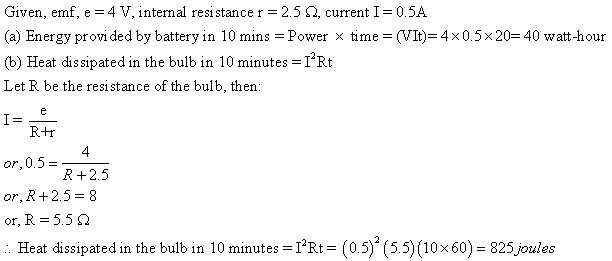
Question 7
(a) What is meant by a ring circuit in house wiring?
(b) What are the advantages of a parallel connection?
(b) What are the advantages of a parallel connection?
Solution 7
(a) The ring system consists of a ring of three wires namely live wire, earth wire and neutral wire, which originate from the main fuse box and after running around the rooms in the house comes back to the main fuse box, thus, completing a ring. In ring system, a separate connection is taken from the live wire of the ring for each appliance. In the ring circuit, all appliances are connected in parallel.
(b) Advantages of a parallel connection are:
(i) In parallel arrangement, each appliance works at the same voltage. For example, if several bulbs are connected in parallel, each bulb glows at the same voltage. Therefore, the glow of a bulb is unaffected if another bulb is switched on or off.
(ii) In parallel arrangement, if one bulb (or appliance
(b) Advantages of a parallel connection are:
(i) In parallel arrangement, each appliance works at the same voltage. For example, if several bulbs are connected in parallel, each bulb glows at the same voltage. Therefore, the glow of a bulb is unaffected if another bulb is switched on or off.
(ii) In parallel arrangement, if one bulb (or appliance
Question 8
(a) Explain with the help of a diagram how does 'short circuiting' occur in an electric kettle.
(b) Out of the wires- live, neutral and earthing, on which line will you connect the fuse and the switch. Give reason for your answer.
(b) Out of the wires- live, neutral and earthing, on which line will you connect the fuse and the switch. Give reason for your answer.
Solution 8
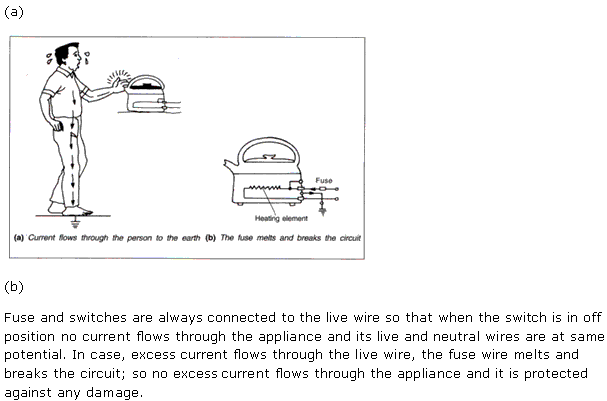
Question 9
What is meant by the term 'electromotive force' of a cell?
Solution 9
When no current is drawn from the cell i.e. when the cell is in open circuit, the potential difference between the terminals of the cell is called its electromotive force (or e.m.f).
Question 10
Explain, why is the p.d. between the terminals of a storage battery less when it is supplying current than when it is on open circuit. A battery of e.m.f. 10 volts and internal resistance 2.5 ohms has two resistances of 50 ohms each connected to it. Calculate the power dissipated in each resistance
(a) When they are in series,
(b) When they are in parallel.
In each case calculate the power dissipated in the battery.
(a) When they are in series,
(b) When they are in parallel.
In each case calculate the power dissipated in the battery.
Solution 10
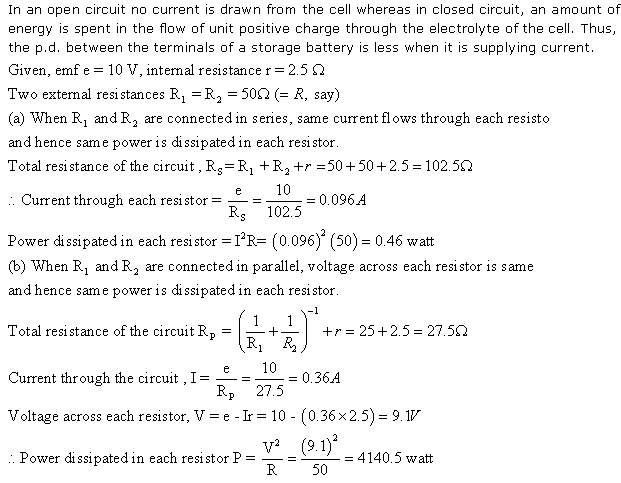
Question 11

Solution 11

Question 12

Solution 12

Question 13
A 3 pin mains plug is fitted to the lead for a 1 kW electric kettle to be used on a 250 V A.C. supply. Which of the following statements is NOT correct?
(a) A 13 A fuse is the most appropriate value to use.
(b) The brown wire should be connected to the live side of the mains.
(a) A 13 A fuse is the most appropriate value to use.
(b) The brown wire should be connected to the live side of the mains.
Solution 13
Incorrect statement:
(a) A 13A fuse is the most appropriate value to use
(a) A 13A fuse is the most appropriate value to use
Question 14
(i) Name the principle on which a transformer works.
(ii) What is the function of a step-up transformer?
(iii) Can a transformer work when it is connected to a D.C. source? Give a reason.
(iv) Draw a simple labeled diagram of a step-down transformer.
(v) Draw a simple labeled diagram of a step-up transformer.
(ii) What is the function of a step-up transformer?
(iii) Can a transformer work when it is connected to a D.C. source? Give a reason.
(iv) Draw a simple labeled diagram of a step-down transformer.
(v) Draw a simple labeled diagram of a step-up transformer.
Solution 14
(i) A transformer works on the principle of electromagnetic induction.
(ii) Function of a step-up transformer is to increase the a.c. voltage and decrease the current.
(iii) No, a transformer cannot work on a d.c. source. With a d.c. source, there will be no change in magnetic flux linked with the secondary coil.
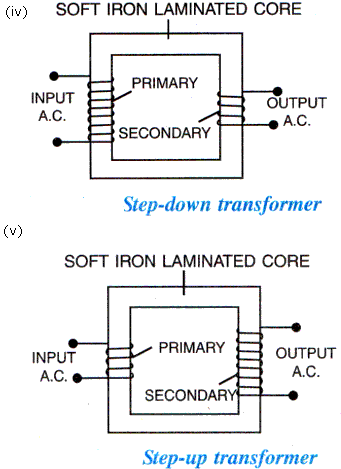
(ii) Function of a step-up transformer is to increase the a.c. voltage and decrease the current.
(iii) No, a transformer cannot work on a d.c. source. With a d.c. source, there will be no change in magnetic flux linked with the secondary coil.

Question 15
The diagram 10 shows two coils X and Y. The coil X is connected to a battery S and a key K. The coil Y is connected to a galvanometer G.
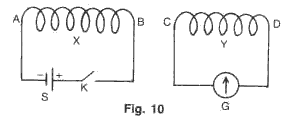
When the key K is closed. State the polarity
(i)At the end of the coil X,
(ii)At the end C of the coil Y,
(iii)At the end C of the coil Y if the coil Y is (a) Moved towards the coil X, (b) Moved away from the coil X.

When the key K is closed. State the polarity
(i)At the end of the coil X,
(ii)At the end C of the coil Y,
(iii)At the end C of the coil Y if the coil Y is (a) Moved towards the coil X, (b) Moved away from the coil X.
Solution 15
(i) Current at the end B of the coil X is anticlockwise therefore at this end there is north pole.
(ii) While closing the key, polarity at the end C of the coil Y will be north. There will be no polarity at the end C of the coil Y when the current becomes steady in the coil X.
(iii) (a) While the coil Y is moved towards the coil X, the polarity at the end C of the coil Y is north.
(b) While the coil Y is moved away the coil X, the polarity at the end C of the coil Y is south.
(ii) While closing the key, polarity at the end C of the coil Y will be north. There will be no polarity at the end C of the coil Y when the current becomes steady in the coil X.
(iii) (a) While the coil Y is moved towards the coil X, the polarity at the end C of the coil Y is north.
(b) While the coil Y is moved away the coil X, the polarity at the end C of the coil Y is south.
Chapter 4 - Current Electricity - Exercises and MCQ Exercise 214
Question 1
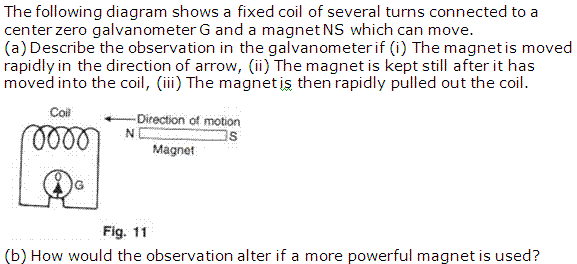
Solution 1
(a) (i) When the magnet is moved rapidly in the direction of arrow, the magnetic flux linked with the coil changes and there is a deflection in the galvanometer, indicating a flow of current through the coil.
(ii) On keeping the magnet still, the magnetic flux linked with the coil does not change and there is no deflection in the galvanometer, indicating that no current is flowing through the coil.
(iii) When the magnet is rapidly pulled out, there is again change in the magnetic flux linked with the coil and the galvanometer shows a deflection but this time in opposite direction, indicating that a current is flowing in opposite direction in the coil.
(b) If a more powerful magnet is used, deflection in the galvanometer will be large, indicating a greater amount of current.
(ii) On keeping the magnet still, the magnetic flux linked with the coil does not change and there is no deflection in the galvanometer, indicating that no current is flowing through the coil.
(iii) When the magnet is rapidly pulled out, there is again change in the magnetic flux linked with the coil and the galvanometer shows a deflection but this time in opposite direction, indicating that a current is flowing in opposite direction in the coil.
(b) If a more powerful magnet is used, deflection in the galvanometer will be large, indicating a greater amount of current.
Question 2
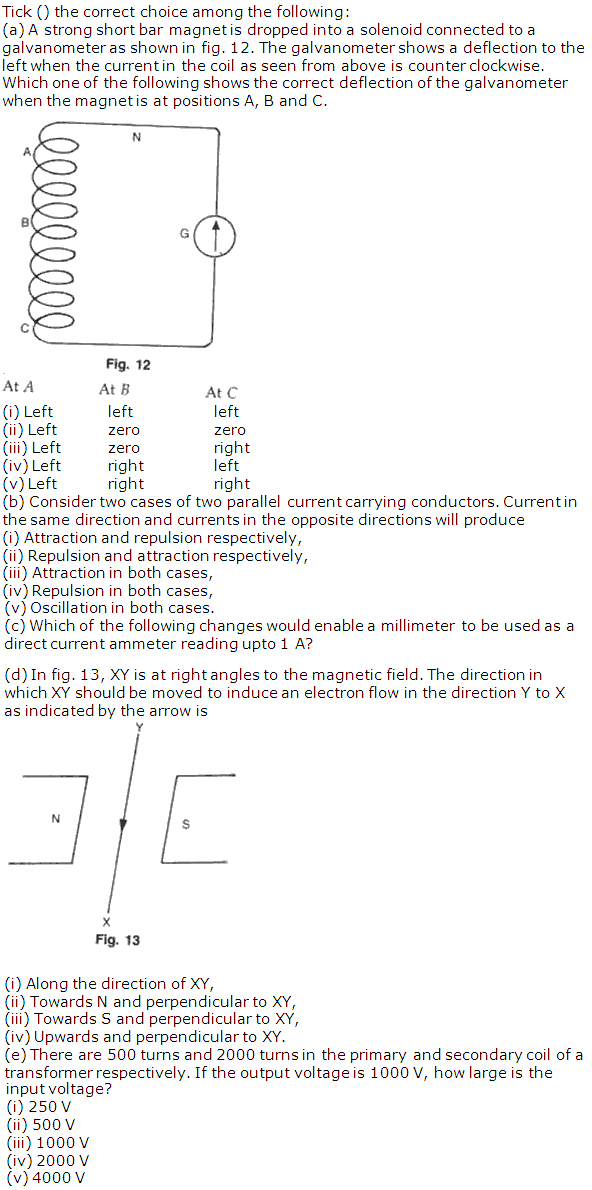
Solution 2
(a) (v) left left left
(b) (ii) repulsion and attraction respectively
(c) (i) connecting a large resistor in series
(d) (iv) upwards and perpendicular to XY
(e) (i) 250 V
(b) (ii) repulsion and attraction respectively
(c) (i) connecting a large resistor in series
(d) (iv) upwards and perpendicular to XY
(e) (i) 250 V
Question 3
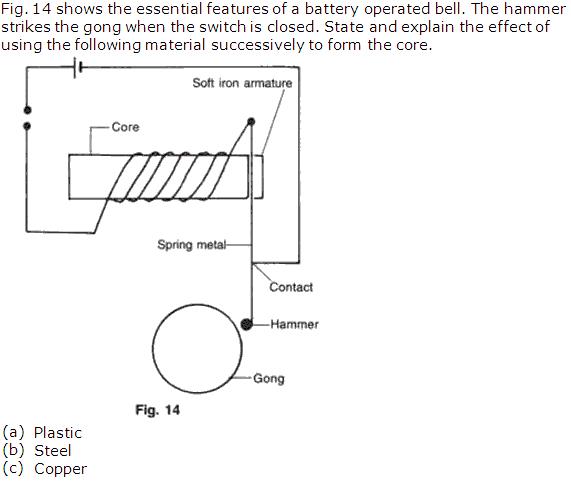
Solution 3
(a) Plastic being non-magnetic cannot be used as a material for core. It shall not intensify the formed magnetic field.
(b) Steel has high retentivity. Hence, after prolonged use even when the switch is off, it may retain some magnetic property and attract the armature.
(c) Using copper as a material for core will introduce eddy currents in the core and thus, interfere with the working of the bell.
(b) Steel has high retentivity. Hence, after prolonged use even when the switch is off, it may retain some magnetic property and attract the armature.
(c) Using copper as a material for core will introduce eddy currents in the core and thus, interfere with the working of the bell.
Chapter 4 - Current Electricity - Exercises and MCQ Exercise 215
Question 1
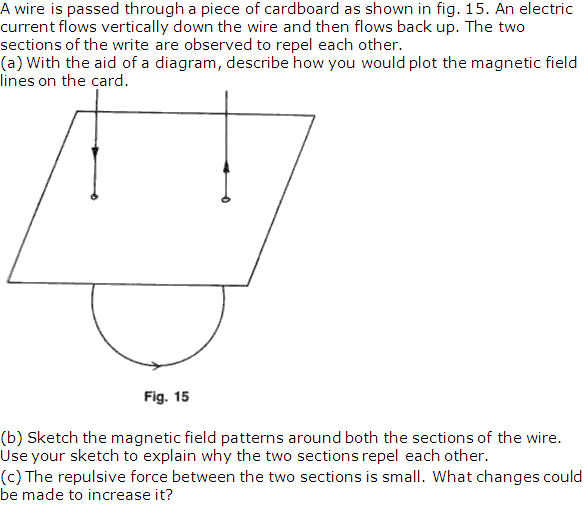
Solution 1

Question 2
Draw and label the diagram of a simple D.C. motor.
(a) Explain the rotation of the coil, giving a reason for your answer.
(b) How can you reverse the direction of rotation of the armature?
(c) How can you increase the speed of rotation of the motor?
(a) Explain the rotation of the coil, giving a reason for your answer.
(b) How can you reverse the direction of rotation of the armature?
(c) How can you increase the speed of rotation of the motor?
Solution 2
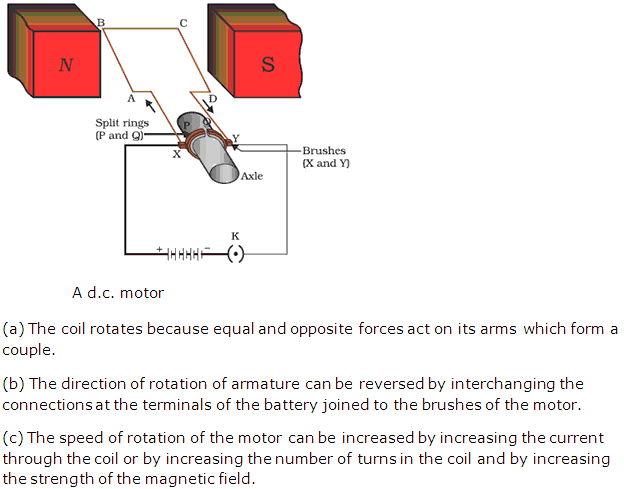
Question 3
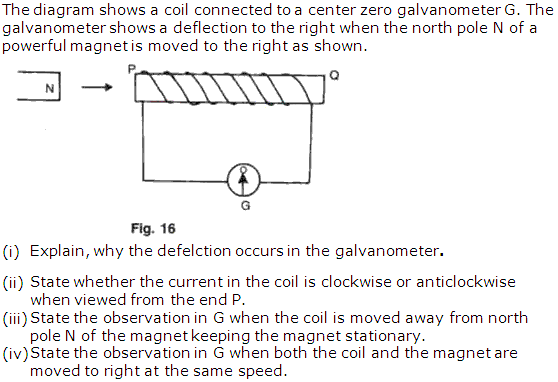
Solution 3
(i) This is due to change in magnetic flux in the coil. Due to change in magnetic flux an induced emf is produced in the coil. Hence, a current flows through the galvanometer.
(ii) The current appears anticlockwise when viewed from end A because end A will form north-pole.
(iii) The galvanometer now deflects towards left.
(iv) No deflection is observed as there is no relative motion between the magnet and the coil.
(ii) The current appears anticlockwise when viewed from end A because end A will form north-pole.
(iii) The galvanometer now deflects towards left.
(iv) No deflection is observed as there is no relative motion between the magnet and the coil.
Question 4
A primary of 800 turns is connected to a 220 V A.C. supply and the secondary has 8 turns. What will be the output voltage?
Solution 4
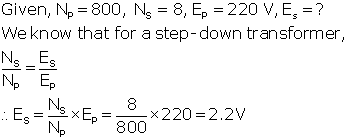
Question 5
How can you convert a moving coil galvanometer into ammeter and voltmeter?
Solution 5
A moving coil galvanometer can be converted into an ammeter by connecting a low resistance (called a shunt) in parallel to the galvanometer.
A moving coil galvanometer can be converted into a voltmeter by connecting a high resistance in series with the galvanometer.
A moving coil galvanometer can be converted into a voltmeter by connecting a high resistance in series with the galvanometer.
Question 6
Why is an ammeter always connected in series while the voltmeter always in parallel to a circuit across which voltage is to be measured?
Solution 6
An ammeter is a low resistance device; hence it is connected in series.
A voltmeter is a high resistance device; hence it is connected in parallel.
A voltmeter is a high resistance device; hence it is connected in parallel.
Question 7
Describe two experiments to illustrate the production of electric current by electromagnetic induction. State the laws which determine the direction and magnitude of the induced current.
Solution 7
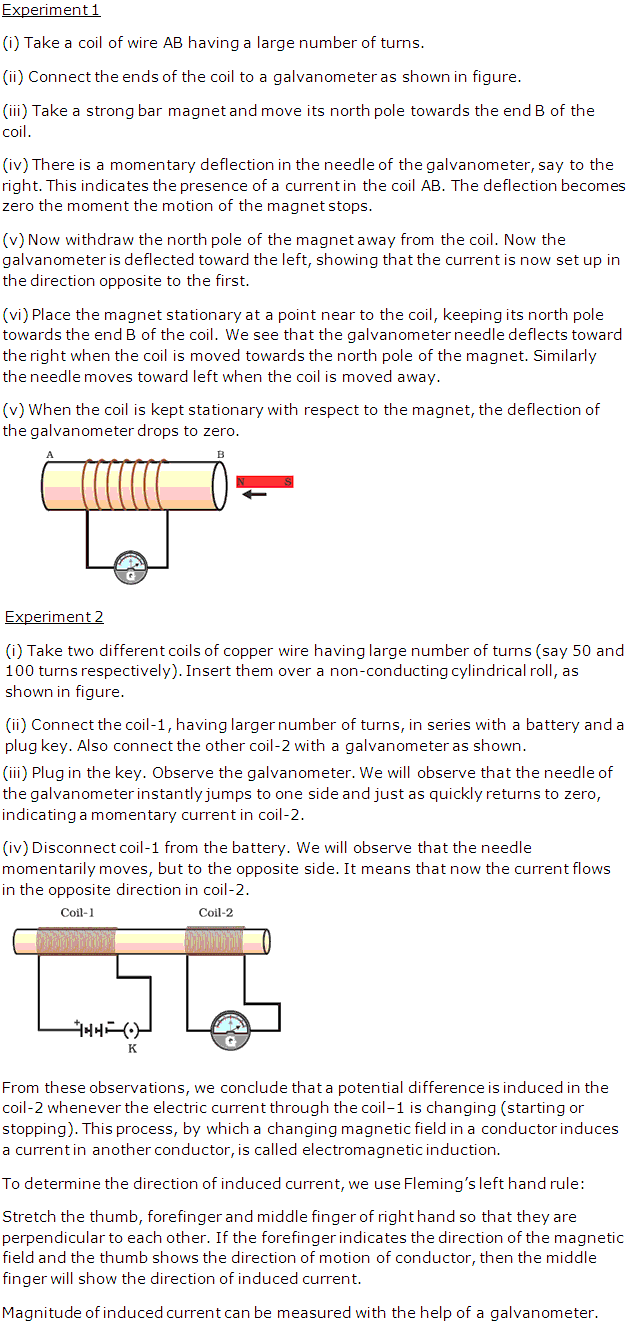
Chapter 4 - Current Electricity - Exercises and MCQ Exercise 216
Question 1
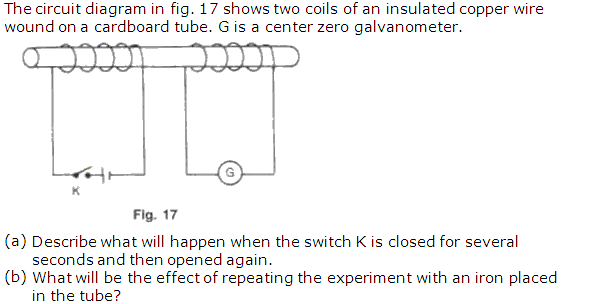
Solution 1
(a) We will observe that the needle of the galvanometer instantly jumps to one side and just as quickly returns to zero, indicating a momentary current in coil connected to galvanometer.
(b) Introducing an iron bar in the tube, will increase the amount of induced current and the galvanometer will show a greater deflection.
(b) Introducing an iron bar in the tube, will increase the amount of induced current and the galvanometer will show a greater deflection.
Question 2
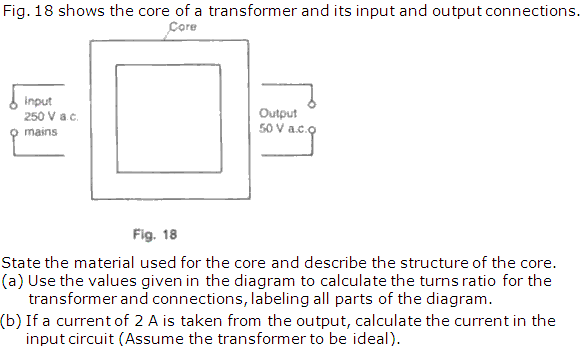
Solution 2
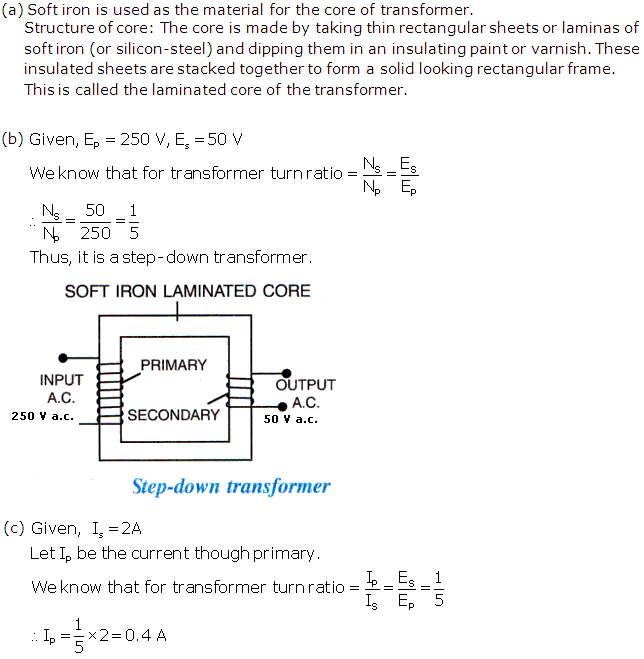
Question 3
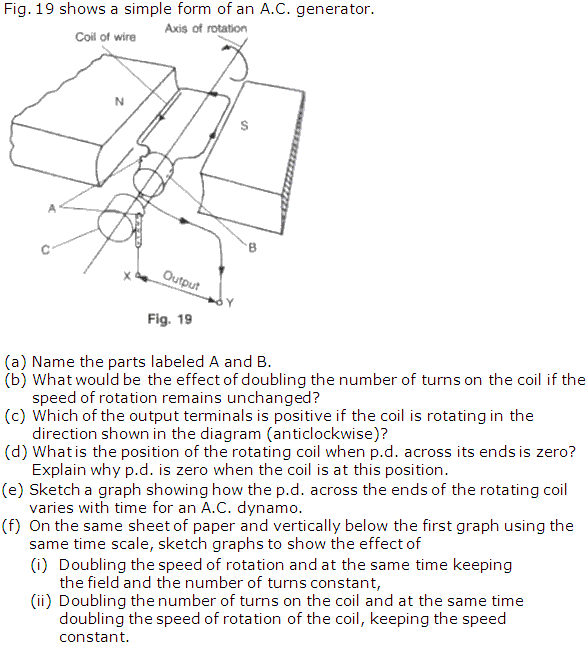
Solution 3
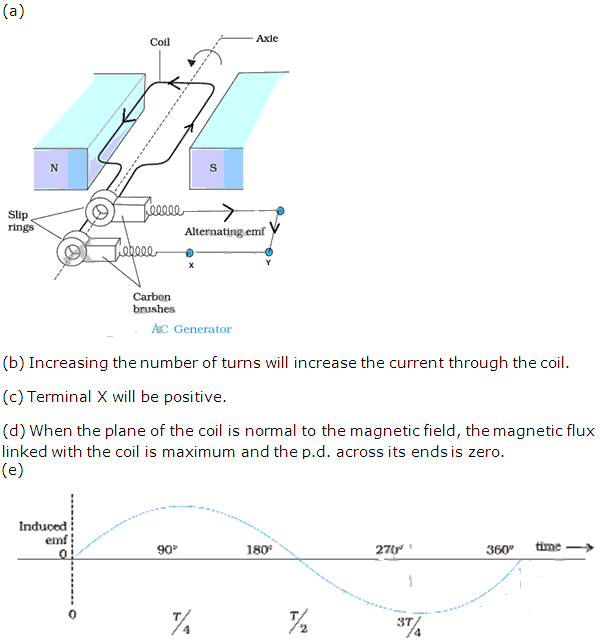
Question 4
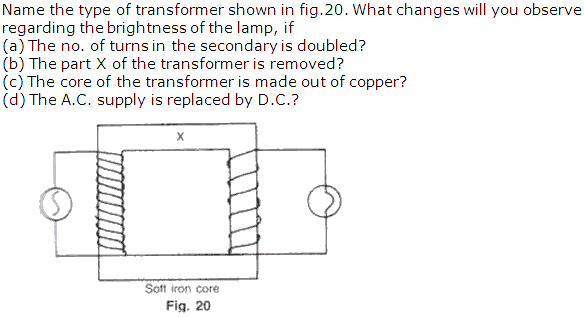
Solution 4
It is a diagram of step-down transformer.
(a) Brightness of bulb will increase because increasing the number of turns in the secondary will increase the change in magnetic flux linked with the coil.
(b) Part X is the core of the transformer is removed, it shall become an open core and there shall be magnetic flux link loss; i.e. the entire magnetic field lines produced by the primary shall not be linked with the secondary.
(c) If the core of the transformer is made of copper due to the formation of eddy currents a lot of energy shall be lost.
(d) A transformer cannot be used with direct current (d.c.) since its working is based on the principle that when there is a change of magnetic field lines due to varying current of same in one coil, an induced varying current of same frequency flows in the other coil. If the current in one coil is constant (i.e. d.c.), no induced current will flow in the other coil since there will be no change in the magnetic field lines linked with the coil.
(a) Brightness of bulb will increase because increasing the number of turns in the secondary will increase the change in magnetic flux linked with the coil.
(b) Part X is the core of the transformer is removed, it shall become an open core and there shall be magnetic flux link loss; i.e. the entire magnetic field lines produced by the primary shall not be linked with the secondary.
(c) If the core of the transformer is made of copper due to the formation of eddy currents a lot of energy shall be lost.
(d) A transformer cannot be used with direct current (d.c.) since its working is based on the principle that when there is a change of magnetic field lines due to varying current of same in one coil, an induced varying current of same frequency flows in the other coil. If the current in one coil is constant (i.e. d.c.), no induced current will flow in the other coil since there will be no change in the magnetic field lines linked with the coil.
Chapter 4 - Current Electricity - Exercises and MCQ Exercise 217
Question 1
A transformer has 400 turns in the primary winding and 10 turns in the secondary winding. The primary e.m.f. is 250 V and the primary current is 2.0 A. calculate:
(a) The secondary voltage,
(b) The secondary current, assuming 100% efficiency.
(a) The secondary voltage,
(b) The secondary current, assuming 100% efficiency.
Solution 1
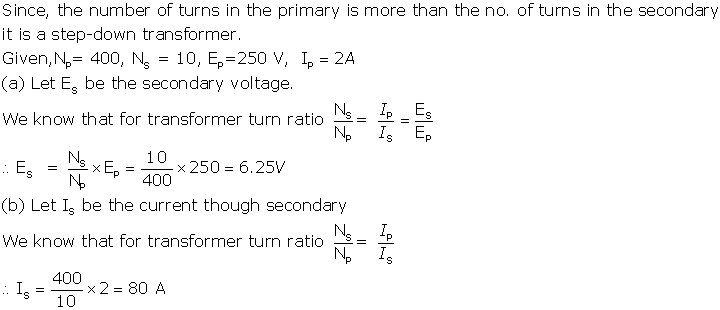
Question 2
Fill in the blanks by writing (i) Only soft iron, (ii) Only steel, (iii) Both soft-iron and steel for the material of core and/or magnet.
(a) Electric bell ______.
(b) Electromagnet ______.
(c) D.C. motor ______.
(d) A. C. generator______.
(e) Transformer______.
(a) Electric bell ______.
(b) Electromagnet ______.
(c) D.C. motor ______.
(d) A. C. generator______.
(e) Transformer______.
Solution 2
(a) magnet - soft iron
(b) core- soft iron
(c) core- soft iron, magnet - steel
(d) core- soft iron, magnet - steel
(e) core-soft iron
(b) core- soft iron
(c) core- soft iron, magnet - steel
(d) core- soft iron, magnet - steel
(e) core-soft iron
Question 3
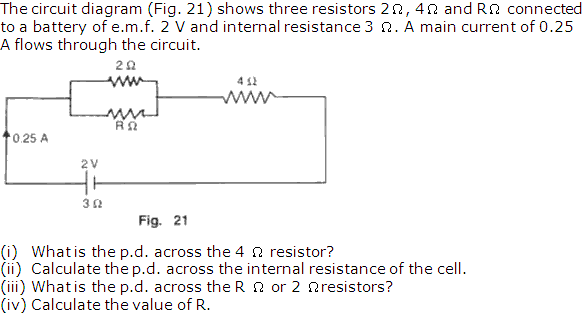
Solution 3
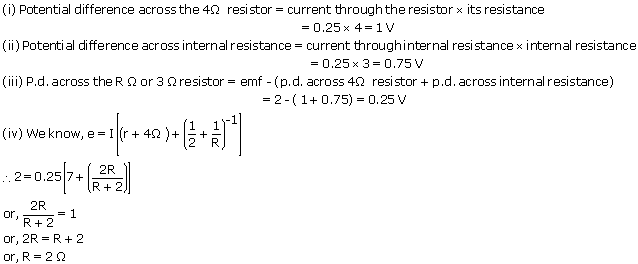
Question 4
Transformers are usually designed so that their efficiency is as close to 100% as possible. Describe two features in transformer design which help to achieve high efficiency?
Solution 4
Features which provide greater efficiency to a transformer are:
(i) The core of the transformer is laminated which prevents the formation of eddy currents.
(ii) A closed soft-iron core is used which reduces the magnetic field link loss and hysteresis loss.
(i) The core of the transformer is laminated which prevents the formation of eddy currents.
(ii) A closed soft-iron core is used which reduces the magnetic field link loss and hysteresis loss.
Question 5
A cell supplies a current of 1.2 A through two 2Ω resistors connected in parallel. When the resistors are connected in series, if supplies a current of 0.4 A. Calculate the internal resistance and e.m.f of the cell.
Solution 5
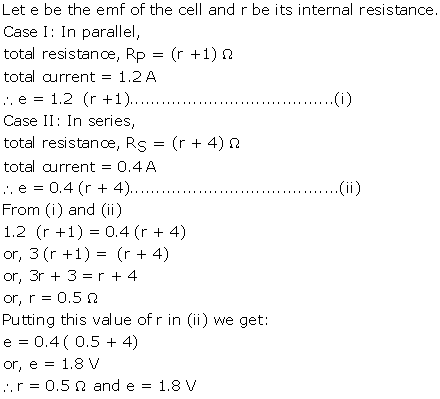
Question 6

Solution 6
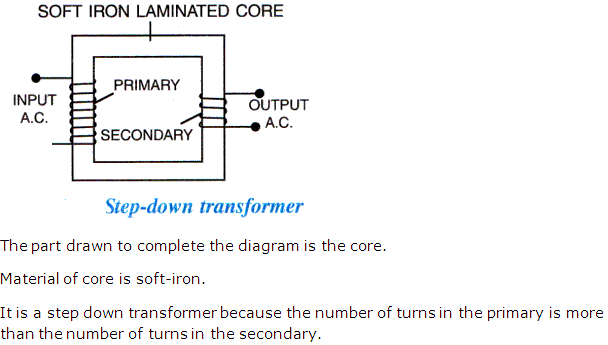
Question 7
Why do you mean by turns ratio of a transformer? Can it work with D.C.?
Solution 7
The ratio of number of turns NS in secondary coil to the number of turns NP in the primary coil (NS / NP) is called the turns ratio.
A transformer cannot be used with direct current (d.c.) since its working is based on the principle that when there is a change of magnetic field lines due to varying current of same in one coil, an induced varying current of same frequency flows in the other coil. If the current in one coil is constant (i.e. d.c.), no induced current will flow in the other coil since there will be no change in the magnetic field lines linked with the coil.
A transformer cannot be used with direct current (d.c.) since its working is based on the principle that when there is a change of magnetic field lines due to varying current of same in one coil, an induced varying current of same frequency flows in the other coil. If the current in one coil is constant (i.e. d.c.), no induced current will flow in the other coil since there will be no change in the magnetic field lines linked with the coil.

0 comments:
Post a Comment